
While many regions globally encourage the installation of solar inverter system for power generation, some customers have reported to our distributors that "during the day, when no one is home, the electricity generated by the solar panels is wasted; at night, when people return home for peak electricity demand, there's no sunshine, forcing them to pay higher peak hour rates." This is a major problem encountered by customers after installing solar inverters. To address this market demand, we have specifically developed inverter that allows for time of use charging and discharging. This is because the inverter's "time setting" is not simply clock calibration, but rather the most fundamental scheduling benchmark in the Energy Management System (EMS). It determines when the battery charges, discharges, switches to grid power, and prioritizes solar power, directly impacting the system's levelized cost of electricity (LCOE), state of operation (SOH), and return on investment (ROI).
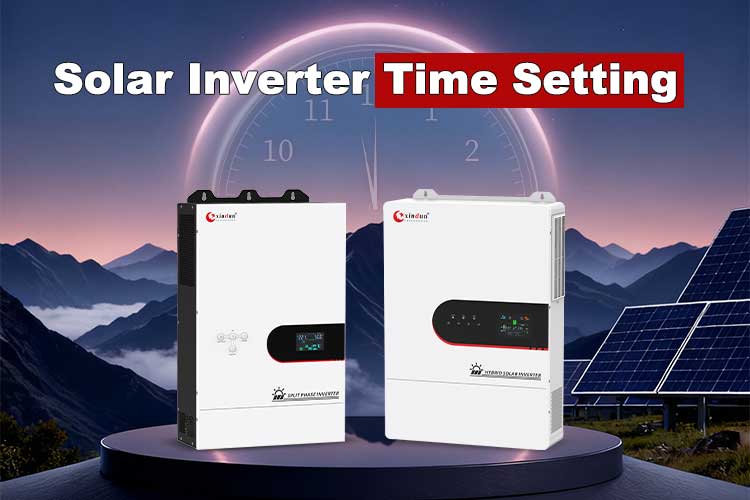
Solar inverter time setting refers to the process of presetting and adjusting time parameters in the inverter control system based on user electricity consumption habits, local solar radiation patterns, and electricity pricing policies. These time parameters are not isolated values, but rather constitute a "timetable" for system energy operation. This timetable serves as the basis for the inverter's intelligent decision making, guiding the system to complete a series of key energy management behaviors such as battery charging, battery discharging, switching between solar and mains power, and prioritizing energy supply. It is a crucial link connecting solar power generation, battery storage, and household electricity consumption, directly determining the overall efficiency and economic benefits of the entire system. When the solar inverter is set to allow time of use mains charging/load operation, the output priority will change to SBU (Signal Based Unit), switching to mains power for charging during the set charging period or after battery over-discharge. If the timed discharge function is also enabled, the system power supply mode will change to UTI (Unified Usage Instructions), switching to mains power only during the set charging period and switching to battery inverter power supply during the set discharge period or when mains power fails (only applicable to off grid mode).
What are the benefits of solar inverter with time of use charging/discharging capabilities? Users can set different charging/discharging periods based on local peak and off peak electricity prices, ensuring efficient use of both grid power and solar energy. When grid power is expensive, the battery inverter supplies power to the load; when grid power is cheap, it can be used to power and charge the load, maximizing electricity cost savings. Users can customize the time of use charging/discharging function. For example, setting the "solar priority charging period" to 8:00-16:00 can be adjusted according to local sunrise and sunset times. During this period, the inverter will automatically prioritize using the electricity generated by the solar panels to charge the battery, avoiding the problem of "solar energy being wasted during the day when no one uses electricity." Furthermore, the time setting can be combined with solar radiation intensity. For instance, during the period of strongest sunlight and highest power generation (10:00-14:00), the inverter can be set to charge the battery at maximum power, maximizing solar energy collection and storage efficiency.
Additionally, it also protects the battery during charging and discharging. For example, setting the battery charging cutoff time to 16:00 means the inverter will stop charging the battery as solar power generation decreases, preventing the battery from being in an inefficient charging state for extended periods and avoiding ineffective charging. On the other hand, it can achieve "timed discharge," addressing the pain point of users' "peak evening electricity consumption." The inverter can be set to start discharging the battery at 17:00, the peak time for users to return home and use electricity, and stop discharging at 22:00. This ensures that peak-hour electricity consumption comes from stored solar energy, rather than expensive grid power, and effectively extends battery life by controlling the discharge time to prevent over discharge.
Xindun's solar inverter feature time setting of use charging/discharging functionality, divided into time of use mains charging, load carrying, and battery discharging functions.
Time of use mains charging/load carrying function: The solar inverter has three customizable time periods, which users can freely set between 00:00 and 23:59. During these user-defined periods, if there is solar energy output, it will be used first. If there is no solar energy output or the solar energy is insufficient, mains power will be used as a supplement.
Time of use battery discharging function: The inverter also has three customizable time periods, which users can freely set between 00:00 and 23:59. During these user defined periods, the inverter will prioritize battery inversion to support the load. If the battery power is insufficient, the inverter will automatically switch to mains power to ensure stable load operation.
Below, we will recommend two Xindun solar inverter with time setting of use charging/discharging functionality:
Battery Voltage: DC 48V
Output Voltage: AC L1-N-L2(L1-L2:200/210/220/240 Volt AC;L1-N/L2-N:100/105/110/120 Volt AC)
Feature:
1. Time of use charging/discharging function:Supports time of use charging/discharging settings, optimizing power usage based on peak and off peak electricity prices to save on electricity costs.
2. Output methods:Supports split phase input and split phase output, or US standard single phase input and single phase output, meeting the power standards of different regions.
3. Parallel operation function:Can connect up to 6 inverters, meeting high power consumption needs in both single phase and three phase system.
4. High efficiency solar energy utilization:Built in MPPT solar controller, with a max input voltage of 500V, significantly improving solar power generation efficiency.
5. Intelligent hybrid power supply: Supports a hybrid power supply of solar energy and mains power for load power and battery charging, and can also supply power to the load when the battery is unavailable (non parallel operation).
6. Safe and long lasting: Lithium battery activation and BMS communication functions ensure battery safety and extend battery life.
Single Phase Parallel Wiring Diagram:
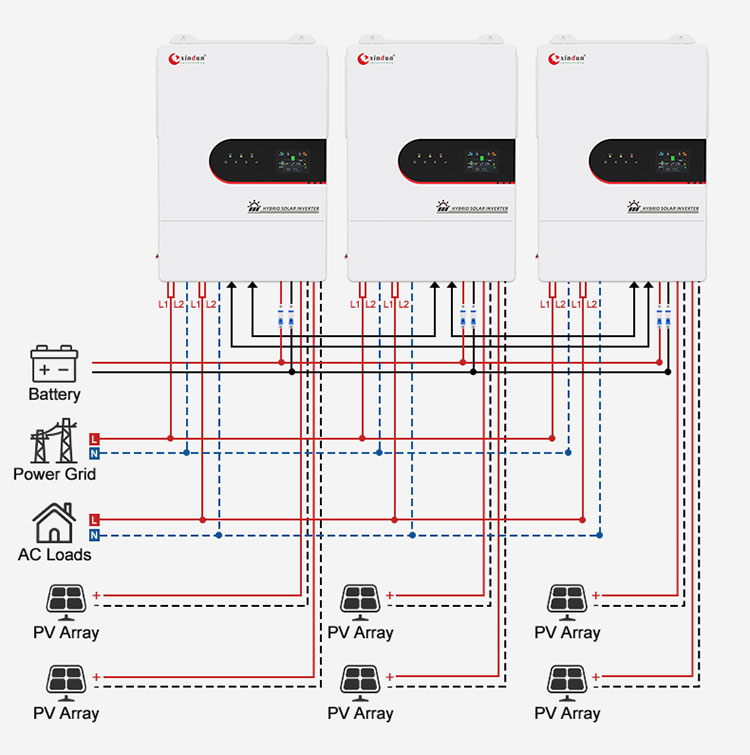
Split Phase Parallel Wiring Diagram:
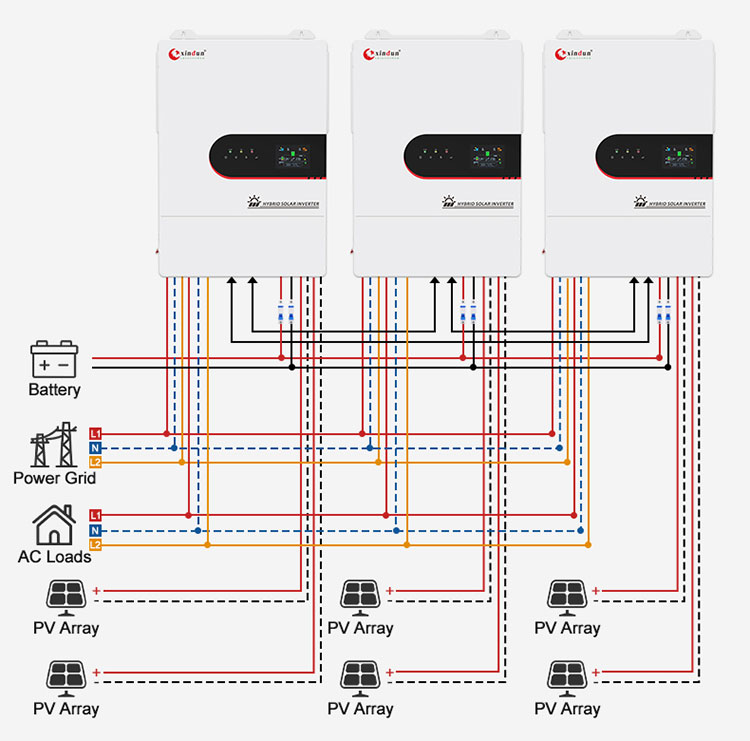
Three Phase Parallel Wiring Diagram:
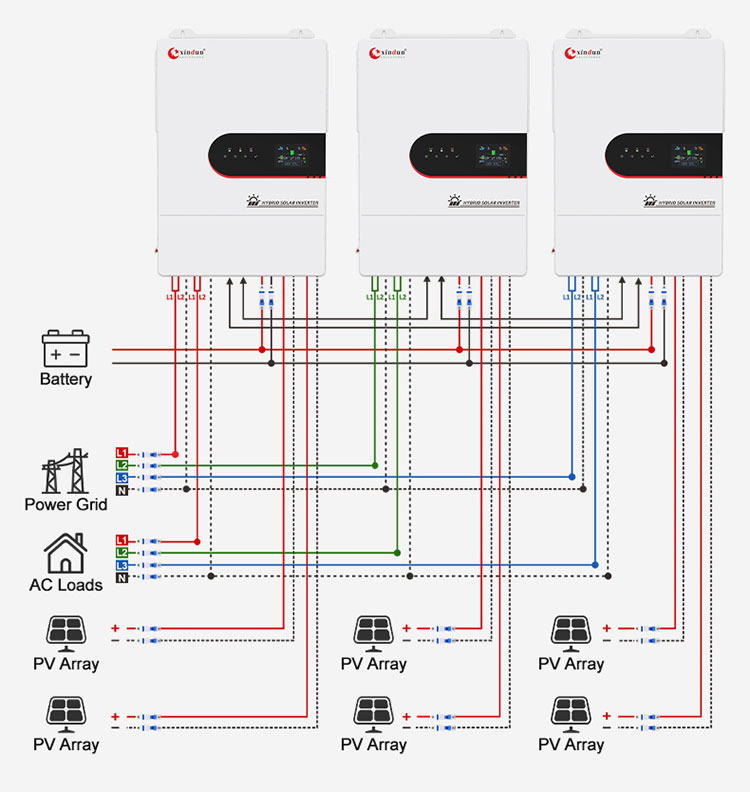
Two Phase Split Phase Parallel Wiring Diagram:
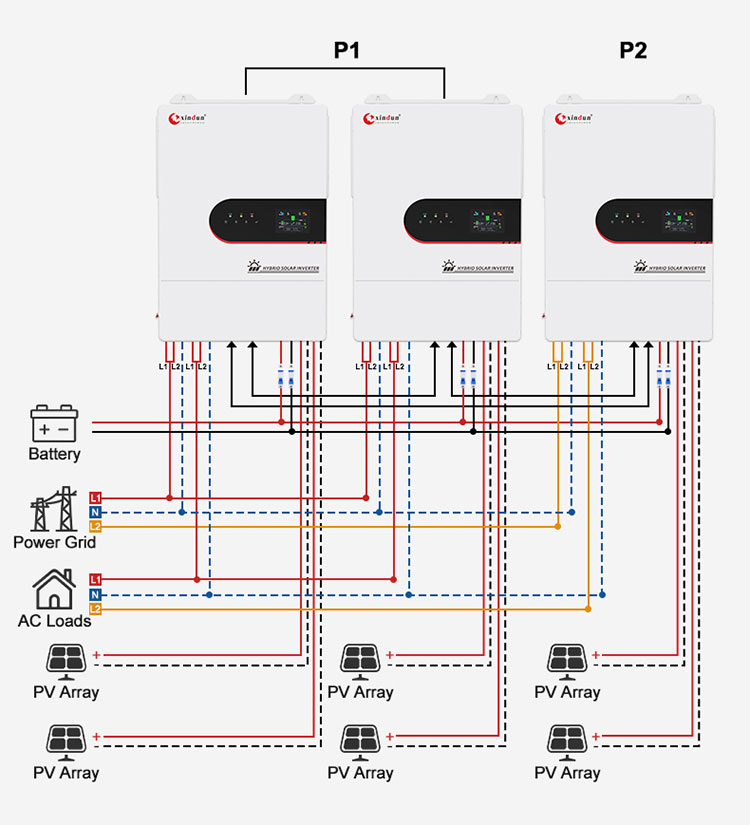
Battery Voltage: DC 48V
Output Voltage: AC 200V/208V/220V/230V/240V
Feature:
1. Energy saving:Supports time setting of use charging and discharging management, allowing for flexible electricity usage based on peak and off peak pricing to reduce electricity costs.
2. Parallel capacity expansion:Supports up to 6 inverters operating in parallel, suitable for single phase or three phase parallel operation.
3. High efficiency power generation: Built in MPPT solar controller, supporting up to 500V solar input to improve solar energy utilization efficiency.
4. Flexible power supply:Supports mixed solar and mains power supply, simultaneously charging the load and battery.
5. Battery-free operation: Can stably power the load even without a battery (non parallel operation).
6. Safe and reliable: Features lithium battery activation and supports BMS communication, extending battery life.
7. Remote monitoring: Supports multiple external communication methods, such as RS485, WiFi, and GPRS, facilitating real time system monitoring and unified management.
Parallel to achieve expanding power:
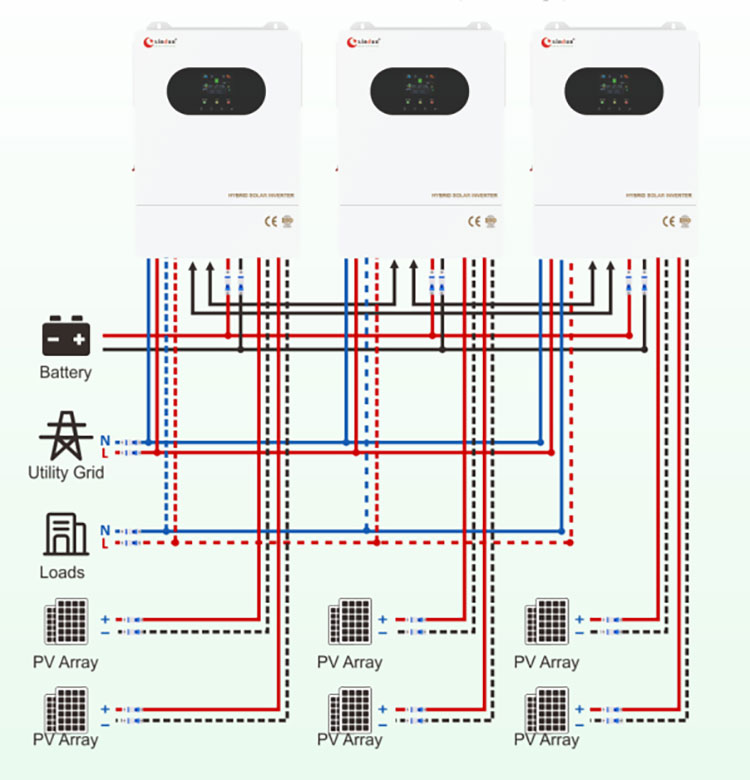
Parallel to achieve 3 phase output:

The above are Xindun Power's solar inverter with intelligent time setting of use charging and discharging capabilities. Utilizing advanced technology and intelligent energy management, they are among the most popular solar inverter on the market, meeting the diverse electricity needs of homes and businesses while helping users achieve more efficient energy use and lower electricity costs. As a solar inverter manufacturer with 20 years of experience, we have a modern production plant of over 10,000 square meters, a professional R&D team, and a comprehensive after sales service system, enabling us to provide customized solar solutions and sustainable economic benefits to customers worldwide.